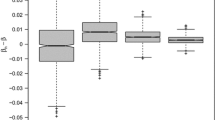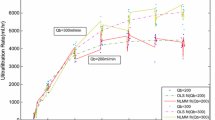Abstract
This paper introduces a weighted Z-estimator for moment condition models, assuming auxiliary information on the unknown distribution of the data and under the assumption of weak dependence (strong mixing processes). We model serial dependence through a simple nonparametric blocking device, routinely used in the bootstrap literature. The weights that carry the auxiliary information are computed by means of generalized empirical likelihood. The resulting weighted estimator is shown to be consistent and asymptotically normal. The proposed estimator is computationally simple and shows nice finite sample features when compared to asymptotically equivalent estimators.



Similar content being viewed by others
Notes
Smith (2011) assumes that the auxiliary set of moments also depends on \(\beta\), while in our case it does not. The final result is different since the asymptotic variance includes extra terms that involve the first derivatives of the auxiliary moments. However, the substance is essentially the same.
References
Altonji JG, Segal LM (1996) Small-sample bias in GMM estimation of covariance structures. J Bus Econ Stat 14:353–366
Bandyopadhyay S (2006) A note on strong mixing. Working Paper
Bevilacqua M, Crudu F, Porcu E (2015) Combining euclidean and composite likelihood for binary spatial data estimation. Stoch Environ Res Risk Assess 29(2):335–346
Bravo F (2009) Blockwise generalized empirical likelihood inference for non-linear dynamic moment conditions models. Econom J 12(2):208–231
Bravo F (2010) Efficient M-estimators with auxiliary information. J Stat Plan Inference 140:3326–3342
Bravo F (2011) Improved generalized method of moments estimators for weakly dependent observations. J Time Ser Anal 32:680–698
Buishand T, Tank AK (1996) Regression model for generating time series of daily precipitation amounts for climate change impact studies. Stoch Hydrol Hydraul 10(2):87–106
Chen J, Qin J (1993) Empirical likelihood estimation for finite populations and the effective usage of auxiliary information. Biometrika 80:107–116
Hau M, Tong H (1989) A practical method for outlier detection in autoregressive time series modelling. Stoch Hydrol Hydraul 3(4):241–260
Ibragimov IA, Linnik YV (1971) Independent and stationary sequences of random variables. Wolters-Noordhoff, Groningen
Kaufmann RK, Stern DI (1997) Evidence for human influence on climate from hemispheric temperature relations. Nature 388(6637):39
Kitamura Y (1997) Empirical likelihood methods with weakly dependent processess. Ann Stat 25:2084–2102
Kuk AYC, Mak TK (1989) Median estimation in the presence of auxiliary information. J R Stat Soc B 51:261–269
Newey WK, McFadden D (1994) Large sample estimation and hypothesis testing. In: Engle R, McFadden D (eds) Handbook of econometrics, vol IV. North Holland, Amsterdam
Newey WK, Smith RJ (2004) Higher order properties of GMM and generalized empirical likelihood estimators. Econometrica 72:219–255
Newey WK, West K (1987) A simple positive semidefinite heteroskedasticity and autocorrelation consistent covariance matrix. Econometrica 50:703–708
Newey WK, West K (1994) Automatic lag selection in covariance matrix estimation. Rev Econ Stud 61:631–653
Owen AB (2001) Empirical likelihood. Chapman-Hall, London
Paruolo P, Murphy B, Janssens-Maenhout G (2015) Do emissions and income have a common trend? A country-specific, time-series, global analysis, 1970–2008. Stoch Environ Res Risk Assess 29(1):93–107
Politis DN, Romano JP (1993) On the sample variance of linear statistics derived from mixing sequences. Stoch Process Appl 45:155–167
Qian H, Schmidt P (1999) Improved instrumental variables and generalized method of moments estimators. J Econ 91:145–169
Rosenblatt M (1956) A central limit theorem and a strong mixing condition. Proc Natl Acad Sci USA 42:43–47
Smith RJ (2011) GEL criteria for moment condition models. Econ Theory 27:1192–1235
Stern DI, Kaufmann RK (1999) Econometric analysis of global climate change. Environ Model Softw 14(6):597–605
Stock J, Kaufmann R, Kauppi H (2006) Emissions, concentrations and temperature: a time series analysis. Clim Change 77(3–4):249–278
Van der Vaart A (2007) Asymptotic statistics. Cambridge University Press, Cambridge
Wang W, Bobojonov I, Härdle W, Odening M (2013) Testing for increasing weather risk. Stoch Environ Res Risk Assess 27(7):1565–1574
Yu G-H, Chen H-L, Wen W-C (2002) A distribution-free method for forecasting non-gaussian time series. Stoch Environ Res Risk Assess 16(2):101–111
Zhang B (1995) M-estimation and quantile estimation in the presence of auxiliary information. J Stat Plan Inference 44:77–94
Zhang B (1996) Estimating a population variance with known mean. Int Stat Rev 64:215–229
Acknowledgements
Federico Crudu’s research is supported by Proyecto Fondecyt Iniciacion N. 11140433 from the Chilean Government. Research work of Emilio Porcu is supported by Proyecto Fondecyt Regular N. 1170290 from the Chilean Government.
Author information
Authors and Affiliations
Corresponding author
Appendix
Appendix
In what follows we present the proofs of the theorems presented in Sect. 3 and some auxiliary results. In addition, we use the following notation: \(\rightarrow _{p}\) and \(\rightarrow _{d}\) denote convergence in probability and convergence in distribution; C is a generic positive constant; CS and T denote Cauchy–Schwarz inequality and triangular inequality respectively; \(\left\| \cdot \right\|\) is the Euclidean norm of \(\cdot\). The CLT is meant to be a central limit theorem for strong mixing sequences (see e.g. Ibragimov and Linnik 1971) and CMT is the continuous mapping theorem.
Proof of Lemma 1
Consider again
Since \(\rho\) is concave on the real line, \(\widehat{R}\) inherits this property, since concavity is closed under linear combinations. Moreover, Assumptions 2–4 match Assumptions (i)–(iii) as in Theorem 2.7 of Newey and McFadden (1994), implying consistency of \(\widehat{\lambda }\). The mean value expansion of the first order for the GEL criterion function can be written as
where \(\bar{g}: =\sum _{i=1}^{b}g_{i}/b\) and \(\dot{\lambda }\) is a mean value between zero and \(\widehat{\lambda }\). Since \(\widehat{\lambda }\) is consistent and \(\left\| \dot{\lambda }\right\| \le \left\| \widehat{\lambda }\right\|\), we have that \(\rho ^{(1)}\left( \dot{\lambda }'g_{i}\right) =-1+o_{p}\left( 1\right)\). Multiplying both sides of the equation above by \(\sqrt{n}\), we obtain
where \(\widehat{\varSigma }=q\sum _{i=1}^{b}g_{i}g_{i}'/b\). Notice that \(\widehat{\varSigma }\sqrt{n}\frac{\widehat{\lambda } }{q}=O_{p}\left( 1\right)\); therefore, direct inspection shows that
The proof is then completed through direct application of CLT as well as Slutsky theorem. \(\square\)
Proof of Theorem 1
[Consistency of \(\widehat{\beta }_{\pi }\)] Let us compute a mean value expansion of
about \(\lambda =0\), where \(\widehat{\lambda }\) is a consistent estimator for \(\lambda\):
From results of Lemma 1 we obtain
and
From Bravo (2009) we have \(\widehat{h}_{\pi }\left( \beta \right) = \widehat{m}\left( \beta \right) +O_{p}\left( M/n\right)\). Then, by adding and subtracting \(\widehat{h}_{\pi }\left( \widehat{\beta }_{\pi }\right)\) and by T, we have
Moreover, by optimality of \(\widehat{\beta }_{\pi }\) and since \(m\left( \beta _{0}\right) =0\), and by some results in Bravo (2009) and T, we get
Assumption 3 implies that \(\sup _{\beta \in {\mathcal {B}}}\left\| m\left( \beta \right) -\widehat{m}\left( \beta \right) \right\| =o_{p}\left( 1\right)\); hence
Since \(m\left( \beta \right)\) is bounded away from zero for \(\left\| \beta -\beta _{0}\right\| >\delta\) (Assumption 2), it follows that \(\widehat{ \beta }_{\pi }\in \left\| \beta -\beta _{0}\right\| <\delta\). As \(\delta\) is arbitrary, \(\widehat{\beta }_{\pi }{\mathop {\longrightarrow }\limits ^{p}}\beta _{0}.\)\(\square\)
Proof of Theorem 2
[Asymptotic Normality of \(\widehat{\beta }_{\pi }\)] Let us consider \(\sum _{i}\widehat{\pi }_{i}h_{i}\left( \widehat{\beta }_{\pi }\right) =0,\) by replacing the probabilities with the expression in Eq. (8), we have
Then, via a mean value expansion of \(h_{i}\left( \widehat{\beta }_{\pi }\right)\) about \(\beta _{0}\), for \(\widehat{\beta }_{\pi }\) being consistent,
where \(\left\| \dot{\beta }-\beta _{0}\right\| \le \left\| \widehat{ \beta }_{\pi }-\beta _{0}\right\|\). Let us define \(\widehat{B}\left( \beta \right) =q\sum _{i}h_{i}\left( \beta \right) g_{i}^{\prime }/b\). Then, by appropriate rescaling and Eq. (7)
where
From Assumption 3 and results in Bravo (2009) \(\sqrt{n}\widehat{h} \left( \beta _{0}\right) {\mathop {\longrightarrow }\limits ^{d}}N\left( 0,S\left( \beta _{0}\right) \right)\) and \(\sqrt{n}\bar{g}{\mathop {\longrightarrow }\limits ^{d}}N\left( 0,\varSigma \right)\). Then, after simple calculations, we get \(A_{1}{\mathop {\longrightarrow }\limits ^{d}}N\left( 0,W\right)\), where
Let us now focus attention on \(A_{2}\). By results in Bravo (2009) and T
Thus,
By CMT and Assumption 3 \(\sqrt{n}\widehat{h}\left( \widehat{\beta }_{\pi }\right)\) is normally distributed. Thus, its order of magnitude is \(O_{p}\left( 1\right)\) and \(A_{3}=o_{p}\left( 1\right)\). Finally,
and
which implies, by CLT applied to \(\sqrt{n}\bar{g}\), Assumption 3 and CMT,
\(\square\)
Proof of Corollary 1
From results in Lemma 1 and Theorem 1 we have
Then, by adding and subtracting \(\mu \left( x\right)\) and multiplying both sides by \(\sqrt{n}\), we get
The result follows from an application of CLT and Slutsky’s theorem. \(\square\)
Rights and permissions
About this article
Cite this article
Crudu, F., Porcu, E. Z-estimators and auxiliary information for strong mixing processes. Stoch Environ Res Risk Assess 33, 1–11 (2019). https://doi.org/10.1007/s00477-018-1602-5
Published:
Issue Date:
DOI: https://doi.org/10.1007/s00477-018-1602-5




